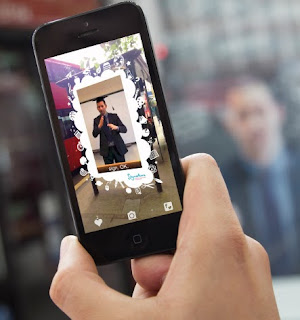If you said
“augmented reality” in Chicago last weekend amidst the droves of aging
Deadheads during their beloved band’s final shows, the words would likely conjure up an
entirely different image than the term’s contemporary meaning.
Today, augmented reality (or “AR”) is arguably one of the
hottest technology trends around.
While it has nothing to do with 1960s-inspired mind-altering substances,
augmented reality promises to take us all down a long, strange trip. But an
exciting one too.
Definition: Augmented reality is a view of a real world object
or environment whose elements are augmented (or supplemented) by computer
generated graphics, sounds, video or other data.
AR is not new, per se. We see it on TV when we watch a
football game and the network artificially places graphics on the field – like the
line of scrimmage or the first down line. For years, Olympic coverage has
super-imposed flags or athlete names on swimming or track lanes to give us more
information to follow the action.
What’s different today, though, is the ubiquitous nature of
smart phones in our world. You and over 5 billion of your closest friends now carry
a mobile device that lets you launch an app, point it at an object and view of
wealth of new information. Consider your reality henceforth augmented.
Meet Your Meat
Consider the following scenario:
You’re at the grocery store looking for some steaks to grill
for the weekend. There are many options, cuts and brands. You want more
information. You point your smart phone at the packaging label and before you
more detail pops up, including when the steaks arrived at the store and who
shipped them. In addition, a 3-D animation appears with audio to describe where
the cow was raised and what it was fed. You can also learn about side dishes
and wine pairings to serve with the steak.
AR is additional content to, ideally, enhance your view of
the world. Think back to 1984 and cyborg assassin Arnold Schwarzenegger as the
Terminator as he methodically sized up his opponent. In real time, data scrolls
across his vision – his opponent’s height, weight, heart rate and background.
Instead of appearing in your field of vision, though, AR data will appear in
your mobile device.
For some great detail on AR, check out two recent compelling
articles in Ars Technica by Lee Hutchinson – “Terminator-vision andthe complex questions behind ‘augmented reality’ ” and “Toss your manual overboard—augmented realityaims at big industry.”
Hutchinson does a nice
job of differentiating augmented reality from its decades-old twin “virtual
reality,” which required helmets, special glasses and expensive set up. He
describes examples from today’s world, such as apps like Sky Guide that allow us
point our phone at the sky and see the constellations.
The potential for AR
growth is huge. Hutchinson
describes Google's app Word Lens that performs real time translations of visual
signs or printed words. Comes in handy next time you’re in a foreign country.
You can imagine that
retailers are all over this. Beer ads will soon be jumping out from cases of
Budweiser at the grocery store. Attractive, happy people will talk you through
clothing options as you browse through the sweater collection at Banana
Republic. You can bet augmented reality Disney characters will chat with you
while you wait in line for 45 minutes before your Disney World ride.
Right Knowledge, Right Time
While the
possibilities are endless, I think training has perhaps the most compelling and
useful applications for augmented reality.
I work in the
corporate learning field, and our constant challenge in training is to get people
the specific knowledge they need for the task they are performing at the right
moment they need it. This concept of
“performance support” could be greatly aided by augmented reality.
Consider, for
example, instead of looking up a diagram on page 479 of a bulky Boeing jet
engine manual, a mechanic points his mobile device at the engine to reveal a
detailed 3-D rendering of all of the intricate parts. He can click on the parts
for descriptions and review relevant instructions, ultimately improving his
ability to fix the issue quickly and accurately.
The Future is Now
 |
| Qualcomm's Geoff Stead |
It’s trippy stuff,
but it’s not futuristic. It’s today. Last month, I attended a mobile learning
conference in Austin, Texas run by the eLearning Guild. During one of the breakout
sessions, Qualcomm’s Geoff Stead showcased a sample of AR featuring a Patent
Wall at Qualcomm’s headquarters. By viewing the wall through your mobile phone,
you have access to detailed information about each of Qualcomm’s many
technology patents.
Software vendors
like Blippar are already hustling to show the value of augmented reality in the
training and consumer markets. Personally, I think the upside is limited only
by our imaginations. I can see bus signs embedded with AR technology so with a
quick look through our phone, the sign reveals the schedule, but also a map of
where the next bus currently is along with the traffic situation.
Personalization with
augmented reality is appealing, but there’s a line where it starts to get
scary.
Imagine you launch
your bank app and discover your checking account balance is low. Payday is 12
days away and your bills are all due soon. As a result, a video pops up before
you to pitch a home equity loan.
As we continue to show
our personal preferences through Facebook “likes,” via Twitter tweets and information
we include on Linked In, how will this data from our social media profile intersect
with augmented reality? What customized messages will it generate?
It’s not quite clear
yet, but while after 50 years Deadheads appear to have ended their long,
strange trip, I’d suggest that ours next journey is about to begin.

